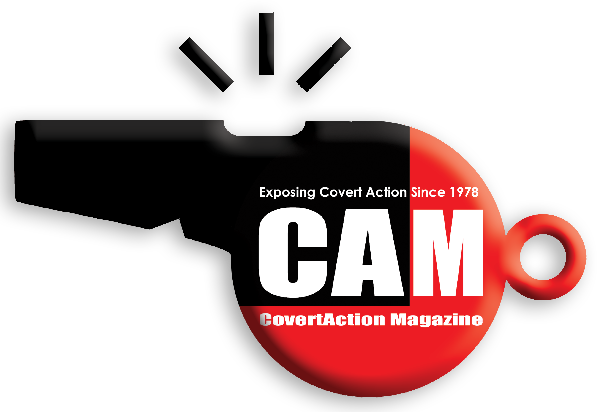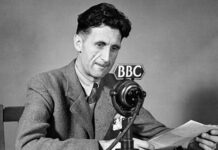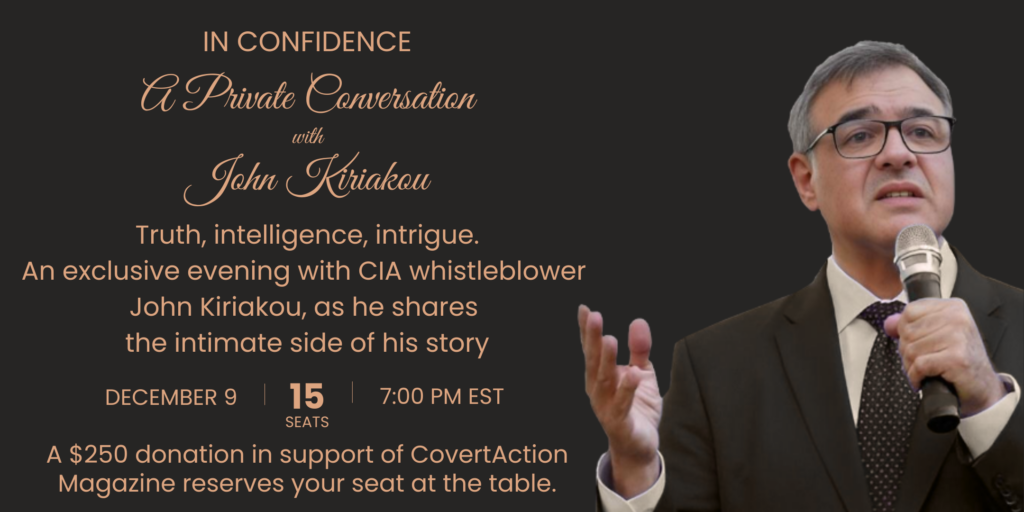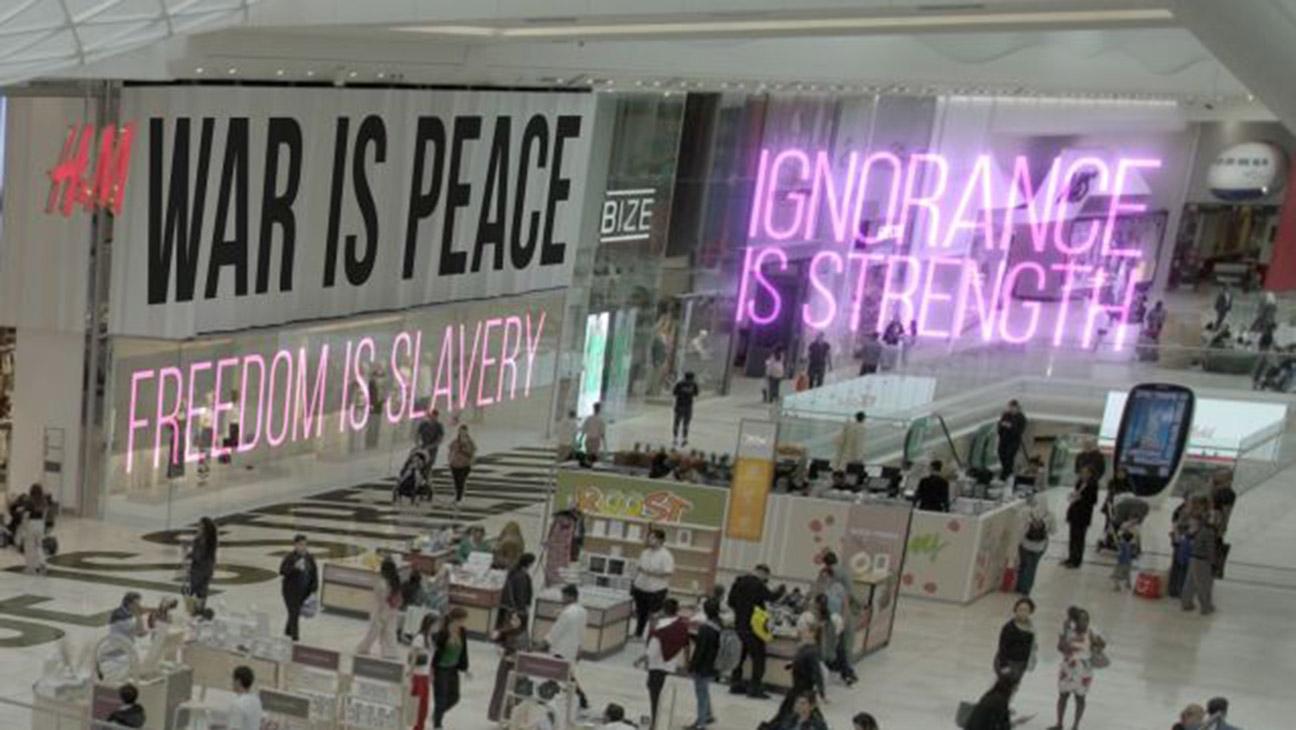
[This article is one of two published by CovertAction Magazine on George Orwell that offer two divergent interpretations about Orwell’s career and legacy. Here is the second, a critical portrait.—Editors]
Orwellian Days
During his first presidency, Trump told 30,573 lies, yet he calls his privately owned online outlet “Truth Social”—which sounds like it is straight out of the Ministry of Truth. Hence, we need to revisit the thinker who is believed to have said “In a time of universal deceit telling the truth is a revolutionary act,” more than ever.
As America lurches headlong toward the authoritarian abyss, two of non-fiction cinema’s top filmmakers have teamed up to create an all-too-timely biopic about literature’s apostle of anti-totalitarianism.
Orwell: 2 + 2 = 5 is written and directed by Raoul Peck, who was Oscar-nominated for the 2016 James Baldwin documentary I Am Not Your Negro, and is co-produced by Peck and Alex Gibney, who won the Best Documentary Academy Award for 2007’s Taxi to the Dark Side and was Oscar-nominated for 2005’s Enron: The Smartest Guys in the Room, and is a five-time Emmy Award winner.
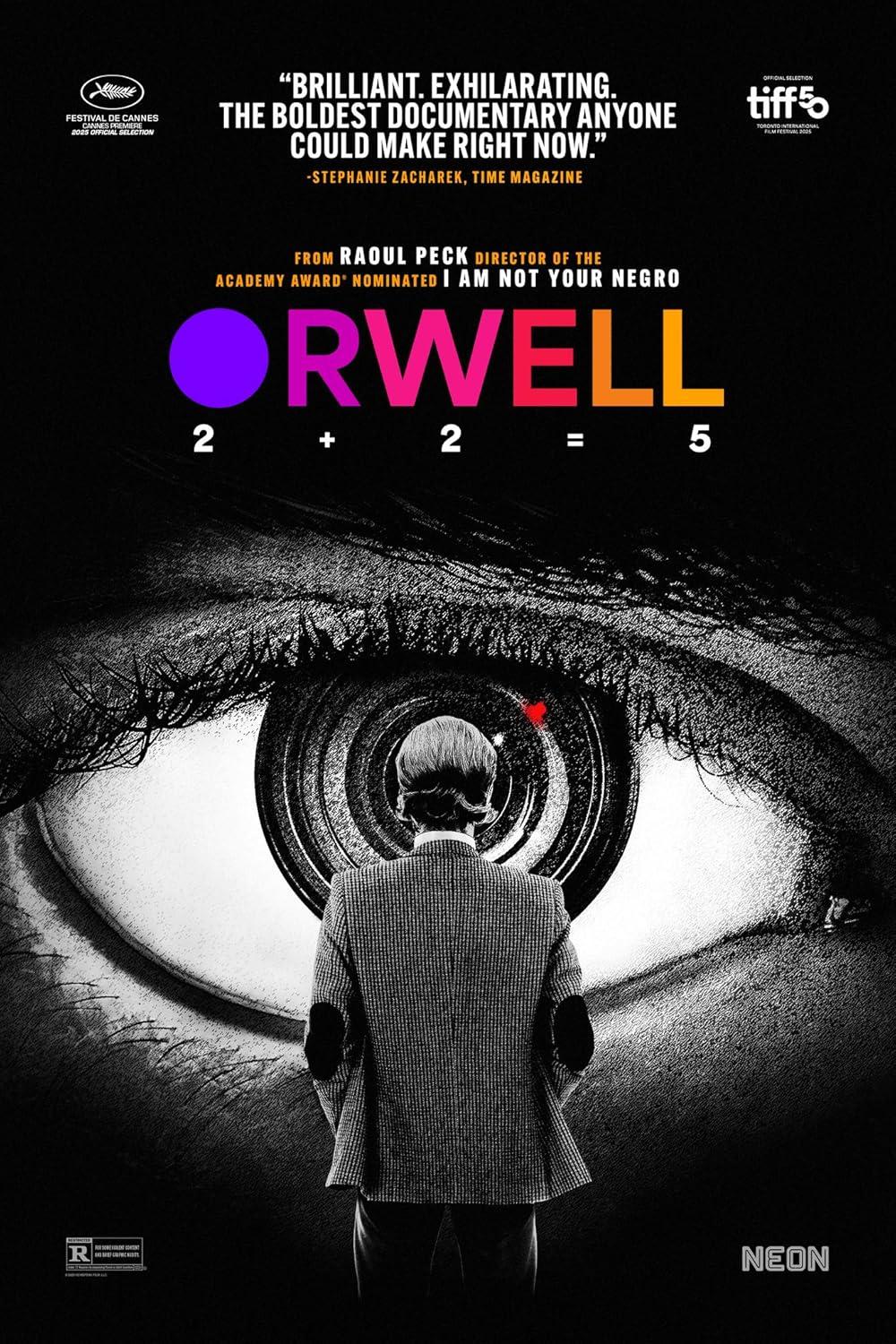
George Orwell is arguably the most successful English language political novelist of all time. He is one of those rare writers whose name has become the basis of an adjective – “Orwellian” – and the creator of that sci fi literary exemplar of dystopian futures, the chilling 1949 novel, 1984 about an über-police state ruled by the all-powerful, omnipresent leader “Big Brother” and the omnivorous surveillance spy agency the “Thought Police.”
Similarly, Orwell’s immortal 1945 fable Animal Farm supremely satirized Stalinism. Although these are his best-known, most influential works, Orwell penned other fiction and non-fiction books, of which I have also read 1933’s Down and Out in Paris and London, 1934’s Burmese Days, and Orwell’s absolutely heartbreaking account of the Spanish Civil War, 1938’s Homage to Catalonia. In addition, Orwell was an excellent essayist, a BBC broadcaster, print journalist and more.
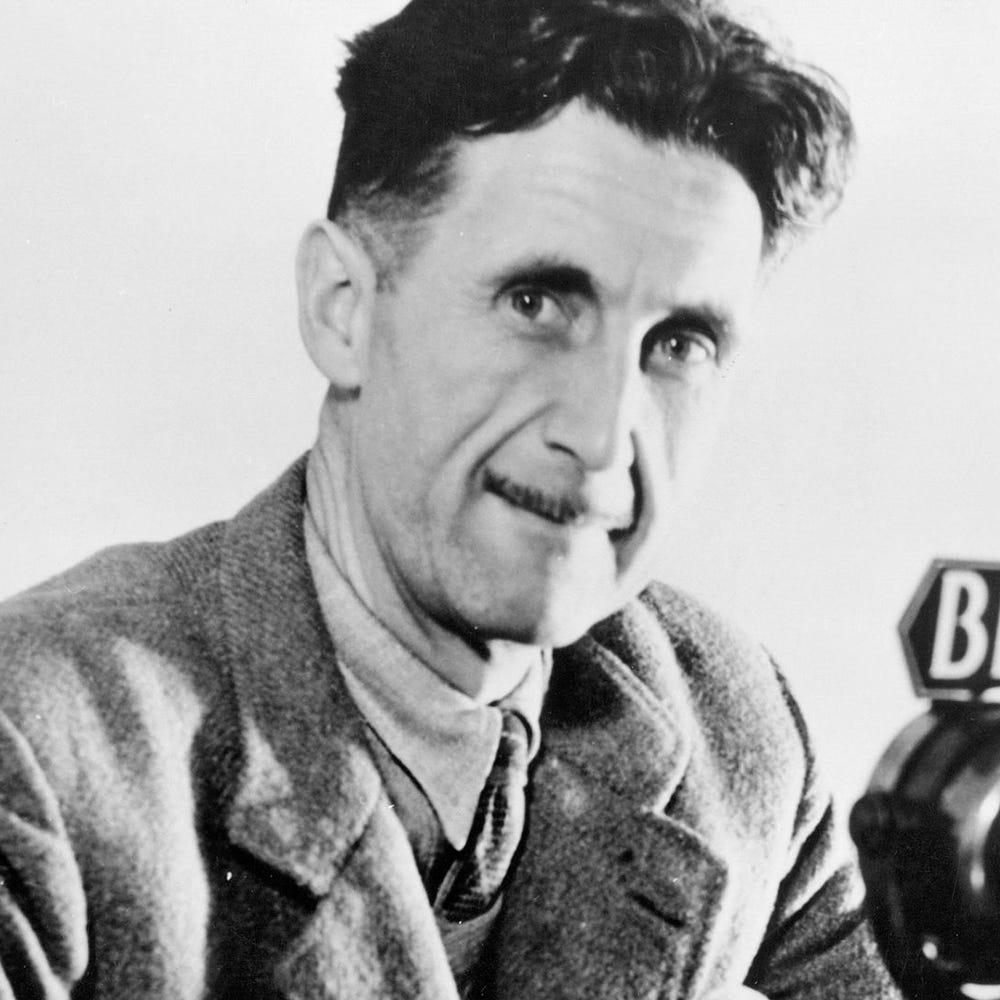
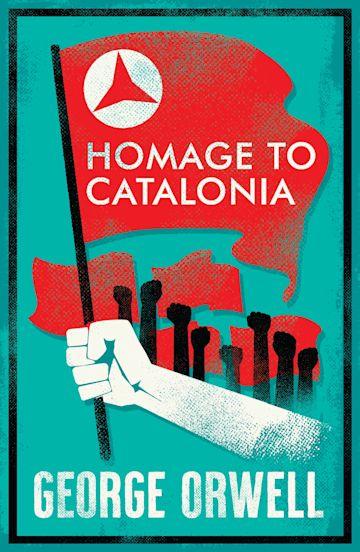
The genius of the Eton-educated Orwell was to be able to take extremely complex topics and themes, break them down into their essence and express them with simplicity, so that the average literate person could understand these ideas. For example, consider this poetic passage from Homage to Catalonia, wherein he describes Barcelona in 1936 as “the revolution was still in full swing…It was the first time that I had ever been in a town where the working class was in the saddle…” I defy you to unearth a pithier evocation of socialism in practice in the English language.
Orwell’s gift was to render complexity with straightforward ease so that ordinary readers could grasp their meaning. His language was as plain and pure as the vernacular of conservatism’s idiot savant, pseudo-sophisticate William F. Buckley, who was pretentiously highfalutin, tossing around $10 words to deflect from the stupidity of his reactionary and white supremacist stances, such as his opposition to 1965’s Voting Rights Act.
I have repeatedly interviewed both Raoul Peck and Alex Gibney, and the two are brilliant intellectuals, certainly the smartest guys in any room.
Peck (with whom I was a schoolmate in the 1960s at Brooklyn’s P.S. 138, although we did not know each other then) graduated from Berlin’s Humboldt University and went on to study at a German film school.
One of the brainiest people I have ever met, Alex Gibney’s stepfather was the renowned anti-war clergyman William Sloane Coffin; he graduated from Yale and studied cinema at UCLA.

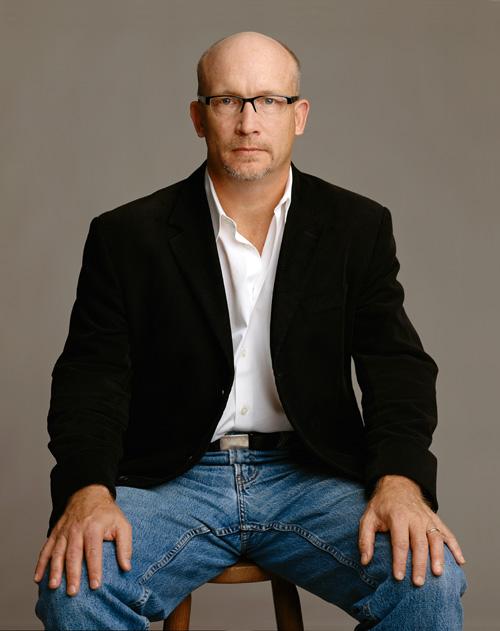
Although Orwell attended (what in America would be called) a private, boarding school, he completed his studies at Eton by the time he was 18 or 19, and did not (unlike Peck and Gibney) go on to university at Oxford, Cambridge, or anywhere else, let alone film or journalism school.
I mention all this because Orwell: 2 + 2 = 5 is an exceedingly complicated, multi-layered two-hour-long film. It opens and closes with what seemed to me to be indecipherable images—was it black-and-white cinematography of a coral reef, with underwater life forms? Or some sort of microbe revealed through a molecular microscope?
In researching this review, I discovered that, according to DEADLINE, it was “an animation of tubercular bacteria…to suggest Orwell’s advancing illness.”
The entertainment industry outlet goes on to theorize: “But that visual motif might just as well signify the unhealthy state of democracies around the world, where autocrats have infected the bloodstream of the body politic with despicable poisons as they assert ever greater control over the minds and thoughts of their subjects.” Who knew?
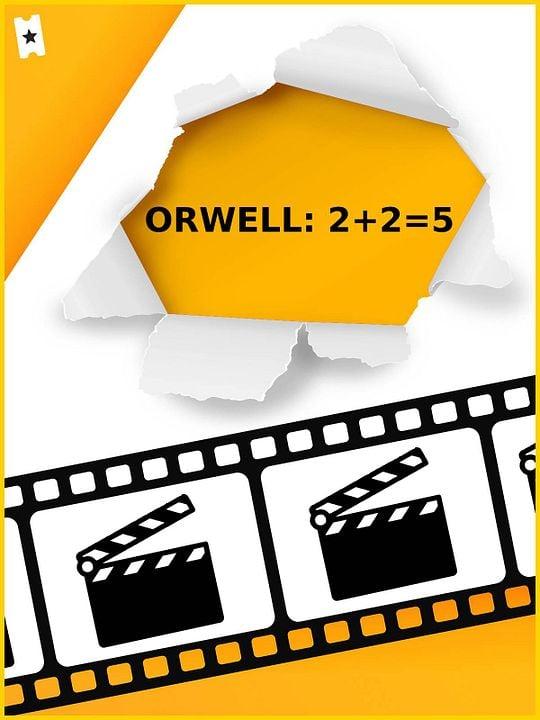
Orwell’s Movie Memory Lane
Orwell: 2 + 2 = 5 traces George’s 1903 birth, long before he assumed a pen name, as Eric Blair in India, where his English father served in the civil service. There are black-and-white photos of Eric’s infancy at the Subcontinent, including a picture of the baby with his very dark-skinned Indian nanny, as well as images of the Blair family and Eric as a lad back in England.
The Blairs are described as being “lower upper-middle class” in a voiceover; actor Damian Lewis (HBO’s Homeland series) reads texts from Orwell’s novels and essays.
Another tack Peck takes in reconstructing Orwell’s life and worldview is by incorporating footage from previously made productions about Orwell or screen dramatizations of his books. There are scenes from 1983’s Crystal Spirit: Orwell on Jura, the Scottish Isle where the ailing author (depicted by English actor Ronald Pickup, who often played historical characters, such as Prime Minister Neville Chamberlain in the 2017 Battle of Britain drama Darkest Hour) wrote 1984. In The Road to 1984, British thespian James Fox portrays Orwell. Michael Moore discusses the wealth of the 1% in a clip from the 2003 documentary Orwell Rolls in His Grave.
Of course, Peck intercuts sequences from various screen versions of Orwell’s masterpiece. I was familiar with the pedestrian 1956 motion picture version of 1984 co-starring Edmond O’Brien as the dissident Winston Smith and Michael Redgrave as an Inner Party member called O’Connor, as well as Michael Radford’s superior iteration that was released in the eponymous year of 1984, starring John Hurt as Winston Smith, Suzanna Hamilton as Julia, and Richard Burton in his final movie role as O’Brien. We are even treated to a glimpse of 1965’s The World of George Orwell: 1984.
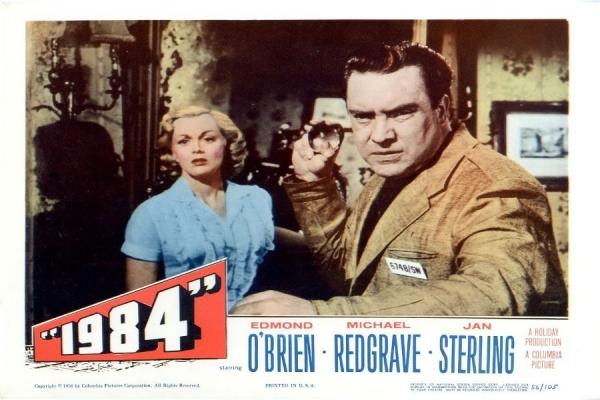
But Peck’s superlative cinematic sleuthing culminates with a revelation, scenes from what is likely the first-ever screen version of Orwell’s magnum opus: The television adaptation of 1984 for the acclaimed anthology drama series Studio One that aired on September 21, 1953. Who knew? (That is, besides Raoul.)
In this ur-1984 rendering shot only four years after the novel’s publication and three years after Orwell’s untimely death, the cast includes none other than Eddie Albert as Winston Smith (long before he starred with Eva Gabor and a pig called Arnold Ziffel (!) in the sixties’ sitcom Green Acres), along with a pre-Bonanza Lorne Greene as Minister of Truth O’Brien. Robert Culp, later of the sixties’ TV series I Spy, has a small role, while Norma Crane played Julia. For film/TV buffs, what a find this is, a real screen gem!
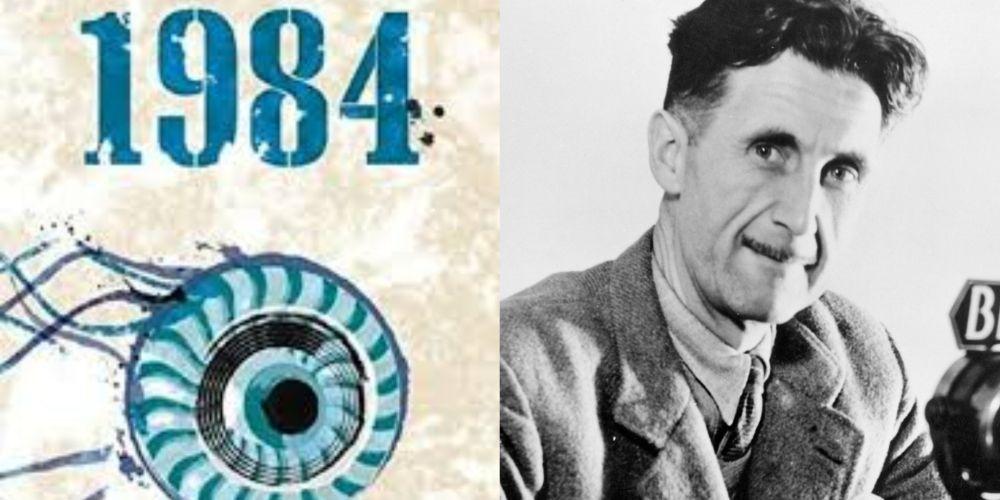
(Although Peck uncovered a number of Orwell-related movie/TV works this film historian was totally unfamiliar with, he missed at least one: 1997’s A Merry War, a silver screen adaptation of the 1936 novel Keep the Aspidistra Flying. In 1998, I crossed paths with its co-star Helena Bonham Carter at the Four Seasons Hotel in Beverly Hills, and when I complimented the English actress on her charming performance in A Merry War, Carter cheekily sounded surprised, saying, “I didn’t think anyone saw that.”)
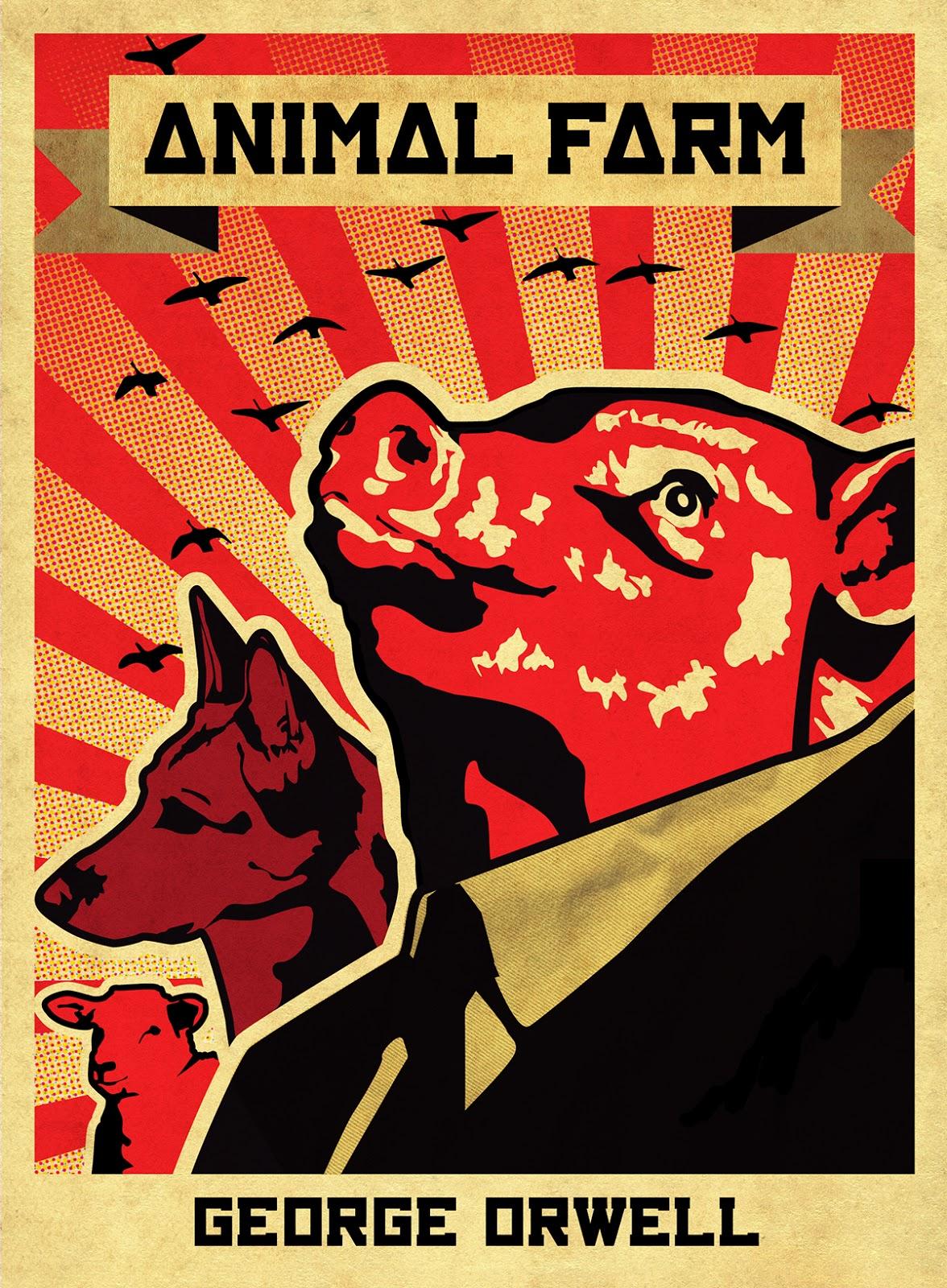
There are also scathing images from a 1996 illustrated edition of Animal Farm wrought by British cartoonist and illustrator Ralph Steadman, as well as a clip from a 1954 animated version of Orwell’s novella about the betrayal of the Russian Revolution, wherein some animals become “more equal than others.”
Newer Newspeak
Orwell: 2 + 2 = 5 is not without wit. In what is probably the documentary’s drollest segment, Peck creatively updates and explains the Orwellian concept of “Newspeak,” the carefully circumscribed, Party-approved language of Oceania (one of 1984’s three superstates or blocs that are perpetually at war with one another, with ever-shifting alliances).
The simplified language of Newspeak is intended to promote mindless obedience and allegiance to Party propaganda, such as Big Brother’s dictum that “War is Peace,” and to eliminate critical thinking and “thoughtcrimes.” Peck provides us with 21st century examples of this “doublethink” and doubletalk often aimed at defending the indefensible, mostly through words onscreen. Ingenious examples intended to raise a smile include these concocted cockamamie mottos:
“Pacification = Elimination of Unreliable Elements”
“Legal Use of Force = Police Brutality”
“Antisemitism 2024 = Weaponized Term to Silence Critics of Israeli Military Actions”
“Stimulus Package = Handouts to the Wealthy”
“Bailouts = Government Welfare for Failing Corporations”
“Austerity = Enforced Economic Deprivation”
“Tax Optimization = Legal Tax Evasion”
“Campaign Finance = Legalized Corruption”
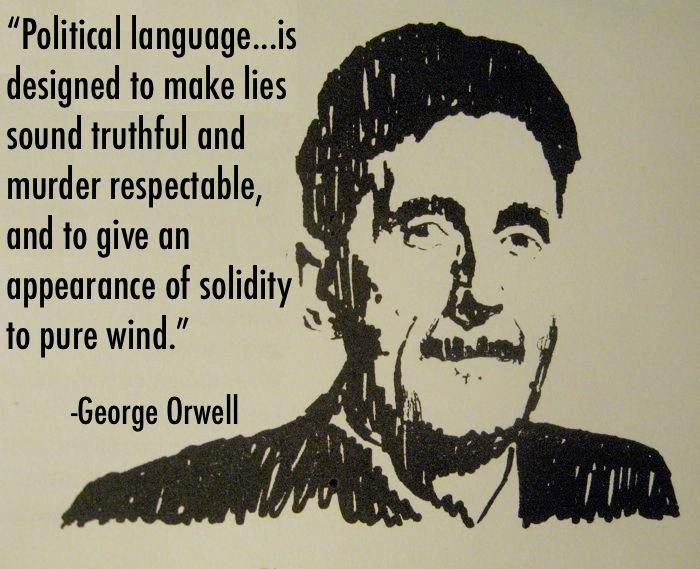
The POUM and Beyond
Peck opens up the scope of his wide-ranging, freewheeling documentary to correlate 1984’s themes, with archival footage and news clips of: the World War II firebombing of Tokyo; Cambodia’s Khmer Rouge; the Ukraine War; Nazi mass rallies; desperate migrants/refugees out at sea (skillfully and eerily set to a voiceover of a passage from 1984); protests against the Rangoon goons in Myanmar (formerly Burma, where Eric Blair had served 1922 to 1927 in the Indian Imperial Police as part of the imperialist apparatus ruling the then-British colony); etc.
Fascist book burnings appear, along with a scene from the 2018 adaptation of Ray Bradbury’s Fahrenheit 451, another classic sci fi look at a dystopian future, wherein firemen do not extinguish fires, but start them—in order to burn books in a largely illiterate society.
There are scenes from Ken Loach’s social realist features, 1991’s Riff-Raff, 2016’s I, Daniel Blake and the 1995 Spanish Civil War movie Land and Freedom, which depicts the POUM, or the Workers’ Party of Marxist Unification, the far-left organization Orwell joined to fight Franco. The extended sequence from Land and Freedom dramatizes POUM members discussing land redistribution policy.
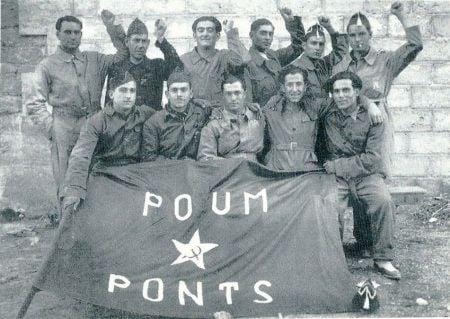
Orwell’s experiences with the POUM were seminal in his philosophical development—not only did he chronicle his activities at the front and Barcelona in Homage to Catalonia (which Andy Durgan calls “In the case of the Partido Obrero de Unificación Marxista, George Orwell’s Homage to Catalonia is the principle account of the experience of these volunteers” of the International Brigades, but his struggles in Spain profoundly impacted Orwell’s worldview.
In addition to his opposition to fascism, he developed a deep distrust of Stalinism and of the revolution betrayed—POUM was part of the Left Opposition and co-founded by Trotskyist Andreu Nin (who I believe is referenced in Peck’s documentary). 1984’s underground opposition leader Emmanuel Goldstein is a thinly veiled reference to Leon Trotsky, Stalin’s arch-nemesis.
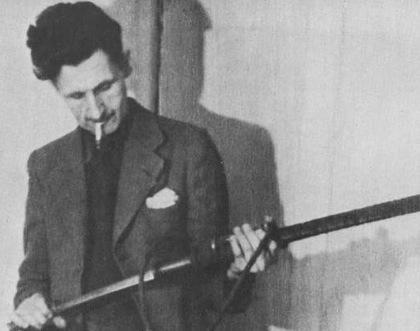
During the Spanish Civil War, according to author Victor Alba, “the POUM was probably the only Marxist party which gained the respect and the solidarity of the anarchists,” and Orwell probably encountered anarchists while he was one of the International volunteers.
Opposing what he perceived to be the twin totalitarian tyrannies of fascism and Stalinism, onscreen in a voiceover in Orwell: 2 + 2 = 5, Damian Lewis reads Orwell’s words: “Every line of serious work I have written since 1936 has been written directly or indirectly against totalitarianism and for democratic socialism, as I understand it.” (This is derived from Orwell’s 1946 essay Why I Write)
Rats
BTW, in Homage to Catalonia, Orwell also discusses a recurring theme that he initially wrote about in his very first novel, 1933’s Down and Out in Paris and London—in addition to despising despotism, George dreaded rats, writing: “If there is one thing I hate more than another it is a rat running over me in the darkness.”
I seem to recall that Orwell wrote he was more afraid of the rats than he was of the armed Falangists.
In any case, Peck intercuts scenes from the ending of different movie versions of 1984 wherein as he is being tortured, ravenous rodents are used to break Winston Smith’s resolve and spirit, as he shrieks in sheer terror, “Do it to Julia!”—his lover—in order to save himself.
Rarely have more heartbreaking words ever been penned in the English language, and Peck fully captures this horror in Orwell: 2 + 2 = 5. Of course, as Orwell dramatizes, the most terrifying rats of all are those who stand on two paws.
Various figures appear throughout Orwell: 2 + 2 = 5, such as Putin, Hitler, Pinochet, high-tech bros Jeff Bezos, Mark Zuckerberg, and Elon Musk delivering stiff armed, Nazi-like salutes, various MAGA cronies such as Rudy Giuliani, Jenna Ellis, and Sidney Powell, and, of course, Big Brother Donald himself, who in one apropos clip declares, “I want surveillance” (although not necessarily of himself).
There are good guys and gals, too, notably über-leaker Edward Snowden (seen in a Glenn Greenwald interview shot by Laura Poitras), who disclosed the NSA’s Orwellian mass surveillance system, and psychologist Shoshana Zuboff, author of 2018’s The Age of Surveillance Capitalism: The Fight for a Human Future at the New Frontier of Power.
A Clockwork Orwell
Of course, Eric Blair/George Orwell himself is a recurring presence interwoven throughout the film, mainly glimpsed in photos or depicted by actors, and, as mentioned, via his texts read aloud by Damian Lewis (just as Samuel L. Jackson voiced James Baldwin’s own words in Peck’s earlier documentary, I Am Not Your Negro).
Orwell: 2 + 2 = 5 follows the non-fiction production’s title character to various sanitariums and hospitals, until his all-too-soon death from complications of tuberculosis at age 46 in 1950. Alas!
There is aerial and other footage of Jura, the Inner Hebrides Scottish Isle where Orwell lived when he was well enough at Barnhill. (How appropriate that the success of Animal Farm enabled him to afford to rent this farmhouse where Orwell wrote 1984.)
It seems to me that the scenes of Jura, presumably shot by Peck, may be most of whatever original material he lensed for what is mostly a “compilation film”—that is, a film that is primarily compiled and composed of footage shot by other filmmakers for various films.
Said frames are then edited to create an entirely new film derived from pre-existing celluloid, often bestowing a contemporary relevance and meaning upon archival footage. Soviet director Esfir Shub pioneered the genre of the compilation film with her 1927 documentary The Fall of the Romanov Dynasty, which marked the tenth anniversary of the Bolshevik Revolution.
Haitian filmmaker Raoul Peck is one of those rare directors who can helm features, as well as documentaries. His 2017 movie The Young Karl Marx was a scripted drama co-starring August Diehl as Marx and Vicky Krieps as Jenny Marx. (See my interview with Krieps wherein she discusses playing Marx’s wife.) Peck directed the anti-colonial 2021 HBO series Exterminate All the Brutes, a hybrid mixture of non-fiction and fiction filmmaking, plus a 1991 documentary and 2000 feature about the assassinated Congolese independence leader Patrice Lumumba. If I have one quibble with Orwell: 2 + 2 = 5 as co-created by Peck and his equally stellar co-producer, Alex Gibney, it is that their film about the writer who made the complicated clear and easy to understand may be too cerebral for us proles. Nevertheless, make sure to watch this engrossing, thought-provoking film about Big Brother watching us.
Having said that, I can still remember when I read 1984, during a trip to Europe when I was only 12 years old. I bought a Penguin paperback edition of the novel, which turned out to be the most absolutely terrifying work of fiction I have ever read. As an atheist, I did not believe in superstitions like werewolves, vampires and ghosts.
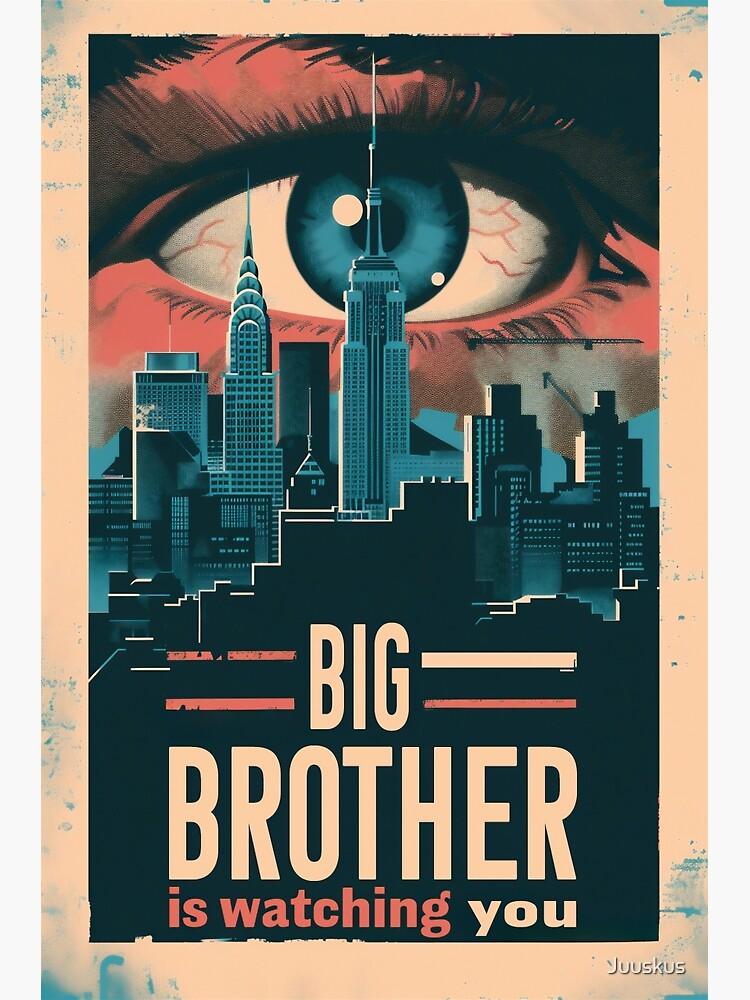
On the other hand, Hitler, Mussolini, Franco and Stalin were all too real, as is the menace of totalitarianism. Over the decades, Orwell’s vision has only become more real—the two-way televisions Big Brother and the Thought Police used to spy on the masses was a clever invention when Orwell dreamed it up in 1948.
But today, that technology, as well as other forms of high-tech surveillance and espionage, are technically available to the state and corporations to watch us—and make sure we obediently follow the Party line.
In this topsy-turvy tyrannical totalitarian-leaning Trumpian time, where truth is an endangered species, as we goosestep toward the surveillance state, Raoul Peck’s masterful Orwell: 2 + 2 = 5 reminds me why, after more than half a century, I have not been able to re-read George Orwell’s red alert cautionary tale because, as we march toward martial law, 1984 remains the scariest page turner I have ever read…
And as for Trump and his MAGA minions complaining about being criticized as “Nazis” and “fascists,” well, as far as this would-be Winston Smith is concerned, if the jackboot fits…
Orwell: 2 + 2 = 5 theatrically opened on October 10 in L.A. and nationwide.
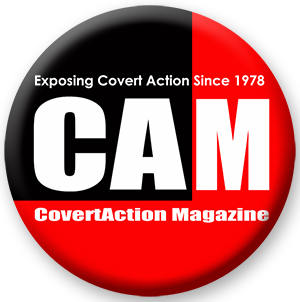
CovertAction Magazine is made possible by subscriptions, orders and donations from readers like you.
Blow the Whistle on U.S. Imperialism
Click the whistle and donate
When you donate to CovertAction Magazine, you are supporting investigative journalism. Your contributions go directly to supporting the development, production, editing, and dissemination of the Magazine.
CovertAction Magazine does not receive corporate or government sponsorship. Yet, we hold a steadfast commitment to providing compensation for writers, editorial and technical support. Your support helps facilitate this compensation as well as increase the caliber of this work.
Please make a donation by clicking on the donate logo above and enter the amount and your credit or debit card information.
CovertAction Institute, Inc. (CAI) is a 501(c)(3) non-profit organization and your gift is tax-deductible for federal income purposes. CAI’s tax-exempt ID number is 87-2461683.
We sincerely thank you for your support.
Disclaimer: The contents of this article are the sole responsibility of the author(s). CovertAction Institute, Inc. (CAI), including its Board of Directors (BD), Editorial Board (EB), Advisory Board (AB), staff, volunteers and its projects (including CovertAction Magazine) are not responsible for any inaccurate or incorrect statement in this article. This article also does not necessarily represent the views the BD, the EB, the AB, staff, volunteers, or any members of its projects.
Differing viewpoints: CAM publishes articles with differing viewpoints in an effort to nurture vibrant debate and thoughtful critical analysis. Feel free to comment on the articles in the comment section and/or send your letters to the Editors, which we will publish in the Letters column.
Copyrighted Material: This web site may contain copyrighted material the use of which has not always been specifically authorized by the copyright owner. As a not-for-profit charitable organization incorporated in the State of New York, we are making such material available in an effort to advance the understanding of humanity’s problems and hopefully to help find solutions for those problems. We believe this constitutes a ‘fair use’ of any such copyrighted material as provided for in section 107 of the US Copyright Law. You can read more about ‘fair use’ and US Copyright Law at the Legal Information Institute of Cornell Law School.
Republishing: CovertAction Magazine (CAM) grants permission to cross-post CAM articles on not-for-profit community internet sites as long as the source is acknowledged together with a hyperlink to the original CovertAction Magazine article. Also, kindly let us know at info@CovertActionMagazine.com. For publication of CAM articles in print or other forms including commercial internet sites, contact: info@CovertActionMagazine.com.
By using this site, you agree to these terms above.
About the Author
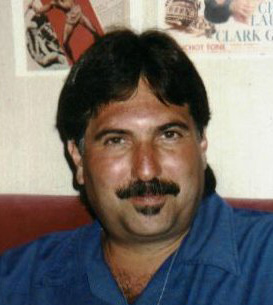
Ed Rampell is an L.A.-based film historian and critic who also reviews culture, foreign affairs and current events.
Ed can be reached at edrampel@gte.net.
